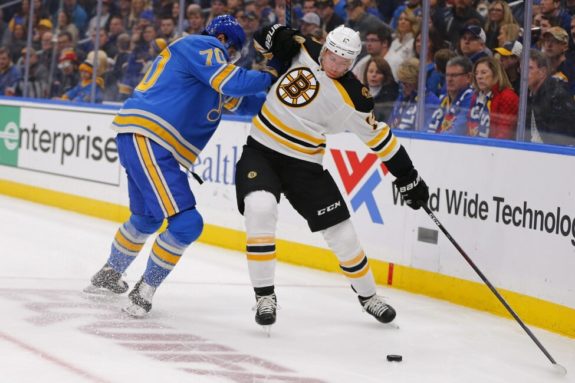The 2020-2021 season was a difficult one for Boston Bruins forward Charlie Coyle. Just 16 points in the entire regular season and only three in two rounds of the playoffs was a severe drop in production from previous years, and the fact that it came after he signed a hefty contract extension worth over $5 million for six years made it much more disappointing. If the Bruins are to avoid regretting that extension, they must see him bounce back and return to producing at a high level.
However, the news of Coyle getting surgery this offseason gives us some insight into why his 2020-2021 performance was subpar. The 29-year-old forward had been playing on a knee injury all season, and it’s possible that this contributed to his struggles. After all, it was only a year ago that he put up 37 points in the regular season, in addition to 16 in the 2019 Playoffs. Before we despair over his lack of production and high-paying contract, we must remember that he has driven this bottom-6 in the past and may be due for a better year.

A good performance from him is going to be crucial for the Bruins’ offense come October. Coyle is the third line center, and much of the team’s depth production starts and ends with him. If he can improve, the bottom-6 will become a cohesive group again.
Areas to Improve
It is apparent from Coyle’s low point production that his offense suffered in 2020-2021. His percentage of scoring chances out of all shots was a middling 26.4%, the lowest of all forwards on the team besides Sean Kuraly. The most noticeable trend in his stats is that, despite taking a relatively large amount of shots, most of them are low-quality, which explains his 7.6% shooting percentage on the regular season.
This isn’t particularly unusual for a player who excels at creating space in the corners and working around the perimeter, but it’s still a decrease from previous years. In both 2018-2019 and 2019-2020, he had 5.99 and 4.91 chances per 60 minutes, respectively, which are significantly higher than this past season, where he only had 4.0 chances per 60 minutes on average. Overall, it seems that Coyle’s ability to find high-quality scoring chances dipped this season.

And yet, perhaps the most telling stats that demonstrate his recent struggles are his goals above replacement (GAR). In 2018-2019, he was in the 57th percentile of players for offense and 98th percentile for defense. In 2020-2021, however, he was in only the 2nd percentile for offense and the 9th percentile for defense.
A knee injury could certainly explain some of this, as it could affect not only his shot but his ability to create power in and around the perimeter where he thrives. His puck-protection and cycling in the offensive zone were less visible on the ice this season, which meant something was preventing him from playing to his strengths. Hopefully, he will be able to find this style of game again after his recovery.
What to Look for Next Season
In Coyle’s case, judging him on his performances before his recent injury may be more insightful. He has been a difference-maker in the playoffs before and a one-man show for the bottom-6 depth more than once. Still, he has a lot to prove this upcoming season as fans (and surely the front office) start biting their nails over that cap hit of $5.25 million.
Latest Bruins Content:
- Every NHL Team’s Longest-Tenured Player
- Today in Hockey History: April 2
- Bruins’ Focus on Responsibility Will Lessen Imprecision
- Every NHL Team’s Most Underrated Prospect
- Pat Maroon’s Bruins’ Debut on the Horizon
First, he must be able to stabilize the third line once again. We saw a constant rotation of forwards go in and out of the third line, from Jake DeBrusk to Nick Ritchie to Sean Kuraly, and it hurt the entire bottom-6. When Coyle was struggling to produce, it seemed to bring the level of play around him down as well; in contrast, he has the ability to elevate his linemates when he is playing well and driving the energy of that line.
#NHLBruins Bruce Cassidy on Charlie Coyle, “Charlie is a horse down low with the puck. Carolina is a lot of man-to-man in D-zone, so this could really be an opportunity for Charlie, like last year, to shine against this team. Because he’s good in those situations.”
— Shawn Hutcheon (@ShawnHutcheon) August 11, 2020
This “stable presence” that Coyle has served in the past is mostly a byproduct of his style of game. He is a puck-possession player that brings physicality and zone dominance on every shift. These are his strengths that create a sense of drive and identity for his line when he is playing to them. If he brings this style to each game next season, we will likely see an improvement from both him and his linemates.
There’s also a chance that Bruins’ general manager Don Sweeney gets a bottom-six winger in the offseason to complement Coyle. This creates an opportunity for Coyle to find a spark with a new teammate, where other options like DeBrusk and Kuraly have been exhausted. However, this also puts more pressure on him to succeed; a move to get another bottom-6 forward would likely cost the team some precious cap space or an asset in a trade, which means an upgrade cannot be wasted by underperforming linemates. Coyle, as the leader of this bottom-6, will have to shoulder this responsibility.
Health Is Number One Priority
The best thing Coyle can do to prepare for a better season is to focus on his recovery. At 29 years old, a knee injury can become a lingering obstacle without a full return to health, and playing through it for the entirety of the 2020-2021 season likely did it no favors. Luckily, he will have a full offseason this year to rest and rejuvenate.
It’s uncertain if he will be able to return to his old form, but the evidence suggests that his recent poor numbers were mostly a fluke caused by the injury. When he is healthy, he will be in a much better position to succeed than he had been in this past season. Now, the opportunity is there for him to go out and quiet his doubters – and the Bruins’ success is going to depend on it.
***
Advanced statistics from Evolving-Hockey and Tableau/Corey Sznajder.